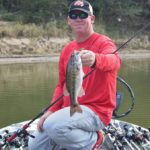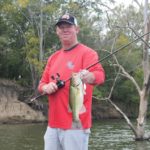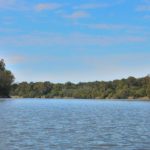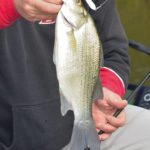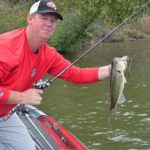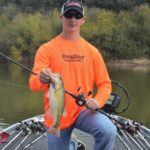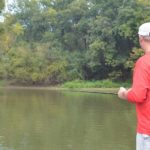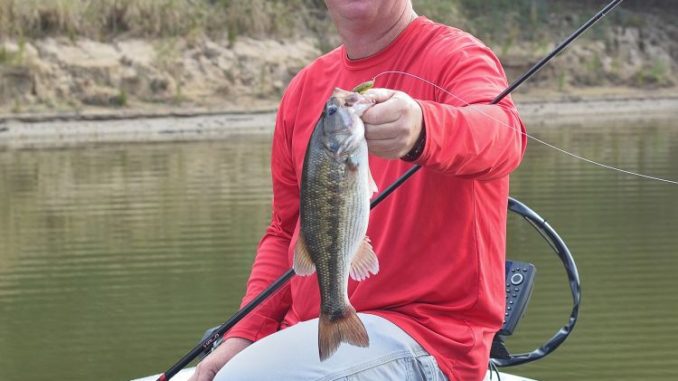
Hit four rivers in one day for the trip of a lifetime
In the heat of the summer, bass fishing on Louisiana’s reservoirs and lakes can be downright sluggish.
Water temperatures spike and bass will seek deeper, cooler water where oftentimes they display a case of lockjaw.
Anglers also complain about the heat as there’s just no escape from the blistering sun when fishing open water.
Fortunately for bass anglers, Louisiana’s rivers come alive with activity in the summer. This is because river water is generally cooler and better oxygenated than inland reservoirs and interior lakes.
And there’s most always a current of some sort in rivers. As many anglers know, bass like to stay on the eddy side of structure in a current where they hide in wait for a crawfish or shad to pass by.
Fishing one river can be fine on any given day, but what about fishing in four in one day? Well, that’s just spectacular.
There’s a location in Louisiana where four rivers converge in Catahoula Parish creating, which creates an extremely fertile watershed for largemouth, spotted bass, yellow bass, white bass and their forage species.
Originating in Polk County, Ark., the Ouachita River flows 510 miles south to Jonesville where it meets the Little River to the west and the Tensas River to the east. Below the convergence of these three rivers, the Black River flows south eventually meeting the Red River.
Stephen Mitchell of Jena knows these waters well and has hardly ever been disappointed with the bass these locations deliver.
He stays continuously on bass reports due chiefly to his occupation as the owner of Town & Country Sportsman’s Haven & Marine in Trout (318-992-6310) — a BassCat dealership and tackle shop in the heart of bass-fishing country in central Louisiana.
The Ouachita
“There’s a lot of fish here,” the 41-year-old said when launching on the Little River from the Archie Recreational Area.
Mitchell was joined by Opelousas’ Kyle Guidry, another BassCat owner, and they traveled east together to start fishing a huge sand bar where the Ouachita and Tensas River meet.
Mitchell began by casting a Carolina-rigged watermelon red Zoom Super Fluke onto the hard shelf of the sand bar adjacent to the main river channel.
Immediately he began catching a combination of largemouths and spotted bass on just about every cast.
“Yeah, they’re here again,” he said. “There have been many tournaments won right off this sand bar.”
Guidry too was catching bass using a Carolina-rigged watermelon red Mister Twister BUZZ Bug. Like Mitchell, Guidry would simply cast and drag the lure on the hard shelf right to where it would disappear on a deeper ledge.
These were your typical Louisiana river bass ranging 2 to 3 pounds, but their numbers well made up for their lack of size when compared to the giants of Toledo Bend.
All of these bass were certainly keepers, and they were numerous enough to weigh and cull on any given tournament day.
Just as Mitchell’s boat was set on heading up the Ouachita, another species attacked his Zoom Super Fluke.
“And we have plenty of these too,” he said, referring to the striped white bass he hoisted aboard.
Mitchell then picked up another rod with a white War Eagle SP3 Jiggin’ Spoon.
“This little spoon has caught a world of these white bass for me,” he said.
“And largemouth, too,” he said chuckling as a black bass was the first fish to be caught on the spoon.
Afterward, numerous white bass were taken and released from the sandbar where largemouth were taken.
Traveling north, the anglers found another sandbar tapering off into the depths and the catching of numbers continued.
Largemouth, white bass and some quality spotted bass were taken and released at this location.
“These hard sand and mud flats off this river are just tremendous in holding numbers of fish as you can see,” he said. “And that’s because of all the shad we see moving along the river right now.
“It’s so simple. If you have moving baitfish and a light current, you’ll catch a load of bass.”
The Black River
At midmorning, Mitchell headed south to the Black River, which is basically a lower extension of the Ouachita.
“The eroding banks here have pushed a lot of trees into the water,” he said. “For me, these laydowns are perfect for spinnerbaits.”
Upon arrival of the first huge tree with branches sticking up from the depths, Mitchell picked up a rod with a ½-ounce War Eagle Blue Herring double willow-leaf spinnerbait attached to it. He began casting to the eddy side of protruding tree limbs.
“Here’s a fish now,” he said hauling a 2 ½-pounder aboard.
“I’ll fish these laydowns all the way to the Jonesville Lock and Dam with spinnerbaits and square-billed crankbaits,” he said.
“You’ll mostly find largemouth and a few spotted bass here, but there are some good weighing fish in this area when the bait is here.”
Just before the Jonesville Lock and Dam on the eastern side of Black River there is a little backwater area that holds fish.
Spinnerbaits, Carolina-rigged plastics and Chug Bugs will deliver bass when they’re eating baitfish in the backwaters here.
Michell worked the waters well here with the spinnerbait scoring near a laydown on the woods side of the area.
Working their way back up the Black River, Mitchell and Guidry scored again on a few spotted bass on the eddy side of jutting sand bars on Carolina-rigged Flukes and BUZZ bugs.
The Tensas River
Reaching the Ouachita again, Mitchell looked at the Tensas River to the east.
“Of the four rivers, the Tensas stays dirtier much of the time,” Mitchell said. “That’s due to a lot of agricultural runoff pouring into it.
“But whenever it is slightly stained, I will certainly go up that river and fish brushpiles and fallen treetops with spinnerbaits, jigs and square-billed crankbaits.”
The angler said that quality bass can be found here under the right conditions.
“On a light current here the bass can turn on, so I will find any eddy behind laydowns, logs and sand bars to throw square-bill crankbaits, lipless crankbaits and spinnerbaits,” he said.
Little River
Little River — which heads west off the Ouachita and travels through Jonesville and the Archie area — can really deliver bass.
On the way back toward the Archie Recreational Area landing, Mitchell stopped at a couple of cuts with waters flowing into Little River.
“You have to be really careful here because there is submerged timber you cannot see all over the mouth of this cut,” he said.
“I have lost plenty of lures here, but it’s worth the effort because it can load up with bass.”
Mitchell picked up another rod this time with a Strike King powder-blue-back-chartreuse 3XD Series crankbait tied on.
On his very first cast, a scrappy largemouth ran off with the lure. Mitchell reeled it in and added it to the livewell.
Guidry stayed with his Carolina-rigged BUZZ bug catching a few bass but breaking off twice on the timber.
“Yep, they’re feeding in here again,” said Mitchell.
Some 18 largemouth were taken at the mouth of this cut alone, and Mitchell was out-fishing Guidry about four fish to one.
“Isn’t it just amazing how many bass can stay in this small opening to this cut?” he asked Guidry.
“There’s just a load of fish in there,” Guidry said.
Mitchell motored west to an almost identical cut, and fish after fish came into the boat as both anglers found the bass quite willing to take their offerings.
“It’s always pretty good here in the afternoons if you have current moving out of the cut,” Mitchell said.
The final count of the mixture of largemouths, spotted bass and white bass that day was somewhere in the 40s — a tremendous testament to the fertility of the Four Rivers watershed.
Four Rivers bass quality
“We do net samples periodically to mainly look at fish species,” said Rick McGuffee, biologist manager at District 3 with the Louisiana Department of Wildlife and Fisheries.
“Certainly the Ouachita provides the best bass fishing in the area,” he said.
“The Tensas River tends to stay muddy mostly and that’s due to agricultural runoff.”
Regarding estimates of bass quality, McGuffee said that most of the sampling is done in hoop nets in the Black River which tends to be deeper than the other rivers.
“And these are done mostly in the summer,” the biologist said.
“But from my experience, the four rivers area offers good fishing for black bass, white bass and crappie, whereas there’s good catfishing in the Tensas River.”
Mitchell stays abreast of tournament results in the area.
“There are seven bass clubs that fish the area and they are the Chickasaw bass club, Miss-Lou bass club, Pigsticker bass club, Concordia bass club, Borderline bass club and the Dixie bass club,” he said.
“In individual competition, if you come to the scales with 12 or 13 pounds — you’ll be in the mix.”
Mitchell said team tournament anglers can expect to place upon catching 15 to 18 pounds.
“Someone can be fortunate and get into a good school of fish here occasionally,” he said. “When practicing for a tournament on the Ouachita one day, my buddy and I made four casts and had 17 pounds.
“Of course, when we went back during the tournament day we didn’t even come close to that weight.”
Mitchell also said anglers will not find much of any submerged aquatic vegetation such as hydrilla.
“You can get in the backwaters areas like Bayou Haw Haw off the Ouachita, and you may see some alligator grass — but that’s about all,” he said.
Anglers would be wise to stay away after thunderstorms because water levels rise fast and the fishing turns off as a result.
“This area does recover pretty quickly however, and under falling waters some great fishing can occur,” he said.
“The huge plus is that bass are quite numerous here and there is little pressure as this location is not too close to major population areas,” Mitchell said.
“It’s a great place to take youngsters out and let them get the experience of catching bass. There’s just a load of success they can enjoy here.”
All four rivers follow the statewide black bass regulations of 10 bass per day per angler with no length limit (largemouth and spotted bass).
Launch/Landing locations
The closest landing to the Four Rivers area is the Jonesville Landing Recreation Area.
It is located across the Little River on its northern banks. Take highway 124 in Jonesville and cross the river then taking highway 3264 to the right where the landing is located.
From there anglers will motor east for a short distance to where they will come to the junction of the Tensas, Ouachita and Black rivers.
Farther to the west, the Little River Recreation area in Archie allows anglers to fish the cuts coming into Little River before they motor over to the Ouachita and Tensas rivers.
The Little River Recreation area offers a boat ramp with two boat ramps each with two lanes. Anglers are to launch on the east side of a small dam there to be able to reach the 4 rivers area.
The Little River Recreation area can be found in Archie along Hwy. 84.
For more information regarding access sights in these areas visit the U.S. Army Corps of Engineers website at www.mvk.usace.army.mil/Missions/Recreation/Ouachita-Black-River.
